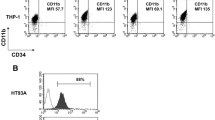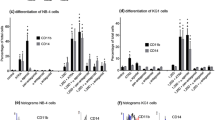Abstract
Human promyelocytic HL-60 cells can be induced by biochemical agents to differentiate in vitro towards divergent types of myelomonocytic cells. It has been reported that prostaglandin E1 (PGE1) can induce granulocytic differentiation and that 1,25-dihydroxyvitamin D3 (1,25(OH)2D3) can induce monocytic differentiation. We have now examined the effects of these compounds, both alone and in combination, on HL-60 cell differentiation. PGE1 (1 μg/ml) or 1,25(OH)2D3 (10 nM) each inhibited cell proliferation over 48–96 hours of treatment, but combined treatment with both agents was necessary to produce a strong inhibition. The percentage of HL-60 cells that can reduce nitroblue tetrazolium (NBT) (a characteristic index of early monocytic or granulocytic differentiation) increased 13-fold within 72 hours of PGE1 treatment, and 1,25(OH)2D3 produced a fivefold stimulation. However, combined treatment (PGE1 plus 1,25(OH)2D3) produced a dramatic 35-fold increase. HL-60 cells did not produce significant levels of nitric oxide (NO) before 48 hours in culture, and treatment with PGE1 or 1,25(OH)2D3 did not significantly increase cellular NO elaboration over control levels. However, combined treatment produced a striking 12-fold increase over control levels. Similarly, combined treatment was necessary to obtain the maximal time-dependent stimulation of cellular lactate dehydrogenase (LDH) activity (a marker of granulocytic differentiation) as well as acid phosphatase (ACP) activity. During this same period of time, PGE1, but not 1,25(OH)2D3, markedly stimulated cellular claboration of interleukin (IL)-1α, IL-6, and tumor necrosis factor (TNF)-α, and 1,25(OH)2D3 cotreatment strongly augmented these effects. Thus, combined treatment with 1,25(OH)2D3 plus PGE1 generally augmented the apparent conversion of these cells, producing synergistic (multiplicative) or additive effects. Furthermore, PGE1 induced within 48 hours the more general phenotypic changes classically associated with the differentiation of these cells: increased expression of chloroacetate esterase (ChAE) (a granulocytic marker), decreases in the nuclear/cytoplasmic ratio (characteristic of development beyond the promyelocyte/myelocyte stage), and major alterations in morphology from floating spherical cells to loosely adherent, elliptical polygons. 1,25(OH)2D3 had little effect itself on most of these parameters, but augmented the morphological changes induced by PGE1 treatment. Within 48 hours, the ability of these cells to reduce the tetrazolium salt WST-1, a general measure of cellular metabolic activity, was increased by PGE1, but not by 1,25(OH)2D3; however, the combination of 1,25(OH)2D3 and PGE1 again produced the strongest stimulation. Similarly, only PGE1 significantly reduced intracellular ATP levels, but combined treatments produced a more pronounced decrease. In summary, our findings suggest that PGE1, not 1,25(OH)2D3, is sufficient to promote rapid in vitro differentiation of HL-60 cells along the granulocytic pathway; however, the PGE1-induced conversion of these cells is markedly augmented by cotreatment with 1,25(OH)2D3. In addition, these converted HL-60 cells preferentially utilize the glycolytic pathway, rather than the citric acid cycle, for production of ATP, a metabolic characteristic that resembles that described for mature granulocytes.
Similar content being viewed by others
References
Collins SJ (1987) The HL-60 promyelocytic leukemia cell line: proliferation, differentiation, and cellular oncogene expression. Blood 70:1233–1244
Chaplinski TJ, Niedel JE (1982) Cyclic nucleotide-induced maturation of human promyelocytic leukemia cells. J Clin Invest 70:953–964
Mangelsdorf DJ, Koeffler HP, Donaldson CA, Pike JW, Haussler MR (1984) 1,25-Dihydroxyvitamin D3-induced differentiation in a human promyelocytic leukemia cell line (HL-60): receptor-mediated maturation to macrophage-like cells. J Cell Biol 98:391–398
Orikasa M, Kawase T, Suzuki A (1993) Induction of macrophagic and granulocytic differentiation of murine bone marrow progenitor cells by 1,25-dihydroxyvitamin D3. Calcif Tissue Int 53:193–200
Perkins SL, Teitelbaum SL (1991) 1,25-Dihydroxyvitamin D3 modulates colony-stimulating factor-I receptor binding by murine bone marrow macrophage precursors. Endocrinology 128:303–311
Bar-Shavit Z, Teitelbaum SL, Reitsma P, Hall A, Pegg LE, Trial J, Kahn AJ (1983) Induction of monocytic differentiation and bone resorption by 1,25-dihydroxyvitamin D3. Proc Natl Acad Sci USA 80:5907–5911
Roodman GD, Ibbotoson KJ, MacDonald BR, Kuehl TJ, Mundy GR (1985) 1,25-Dihydroxy-vitamin D3 causes formation of multinucleated cells with several osteoclast characteristics in cultures of primate marrow. Proc Natl Acad Sci USA 82:8213–8217
MacDonald BR, Takahashi N, McManus LM, Holahan J, Mundy GR, Roodman GD (1987) Formation of multinucleated cells which respond to osteotropic hormones in long-term human bone marrow cultures. Endocrinology 120:2326–2333
Takahashi N, Kukita T, MacDonald BR, Bird A, Mundy GR, McManus LM, Miller LM, Boyde a, Jones SJ, Roodman GD (1989) Osteoclast-like cells form in long-term human bone marrow but not in peripheral blood cultures. J Clin Invest 83:543–550
Shinar DM, Sato M, Rodan GA (1990) The effect of hemopoietic growth factors on the generation of osteoclast-like cells in mouse bone marrow cultures. Endocrinology 126:1728–1735
Pantazis P, Lazarou SA, Papadopoulos NM (1981) Isoenzymes of lactate dehydrogenase in human leukemic cells in culture treated with inducers of differentiation. J Cell Biol 90:396–401
Ishiyama M, Shiga M, Sasamoto K, Mizoguchi M, He P-G (1993) A new sulfonated tetrazolium salt that produces a highly water-soluble formazan dye. Chem Pharm Bull Tokyo 41:1118–1122
Bradford MM (1976) A rapid and sensitive method for the quantitation of microgram quantities of protein utilizing the principle of protein binding. Anal Biochem 72:248–254
Orikasa M, Kawase T, Shimizu F, Suzuki A (1991) Establishment of murine macrophage-like mutant and hybrid cell lines: comparative analysis of the differentiation induced by 1α,25-dihydroxyvitamin D3 and recombinant murine interferon-γ. Cell Immunol 132:350–365
Ding AH, Nathan CF, Stuehr DJ (1988) Release of reactive nitrogen intermediates and reactive oxygen intermediates from mouse peritoneal macrophages. J Immunol 141:2407–2412
Ogata S, Suzuki A, Kawase T (1995) A rapid quantitative analysis of intracellular nucleotides in osteoblasts using a high-performance liquid chromatography. Jpn J Oral Biol 37:1–8
Minakami S (1979) Biochemistry in neutrophils. In: Minakami S, Kakinuma K (eds) Neutrophils and phagocytosis (in Japanese) Kodansha, pp 82–93
Morris SM Jr, Billiar TR (1994) New insights into the regulation of inducible nitric oxide synthesis. Am J Physiol 266:E829–839
Damoulis PD, Hauschka PV (1994) Cytokines induce nitric oxide production in mouse osteoblast. Biochem Biophys Res Commun 201:924–931
Ralston SH, Todd D, Helfrich M, Benjamin N, Grabowski PS (1994) Human osteoblast-like cells produce nitric oxide and express inducible nitric oxide synthase. Endocrinology 135:330–336
Punjabi CJ, Laskin DL, Heck DE, Laskin JD (1992) Production of nitric oxide by murine bone marrow cells. J Immunol 149: 2179–2184
Takagi K, Hosaka T, Suketa Y (1991) Effect of recombinant human interleukin-6 on nitrite production of mouse myeloid leukemia cells. J Cell Physiol 147:306–310
Magrinat G, Mason SN, Shami PJ, Weinberg JB (1992) Nitric oxide modulation of human leukemia cell differentiation and gene expression. Blood 80:1880–1884
Munoz-Fernandez MA, Cano E, O'Donell CA, Doyle J, Leiw FY, Fresno M (1994) Tumor necrosis factor-α (TNF-α), interferon-γ, and interleukin-6 but not TNF-β, induce differentiation of neuroblastoma cells: the role of nitric oxide. J Neurochem 62:1330–1336
Shapiro IM, Debolt K, Hatori M, Iwamoto M, Pacifici M (1994) Retinoic acid induces a shift in the energy state of hypertrophic chondrocytes. J Bone Miner Res 9:1229–1237
Higgins CF, Cairney J, Stirling DA, Sutherland L, Booth IR (1987) Osmotic regulation of gene expression: ionic strength as an intracellular signal? Trend Biochem Sci 21:339–344
Chamberlin ME, Strange K (1989) Anisosmotic cell volume regulation: a comparative view. Am J Physiol 257:C159-C173
Abate C, Patel L, Rauscher FJ III, Curran T (1990) Redox regulation of Fos and Jun DNA-binding activity in vitro. Science 249:1157–1161
Toledano MB, Leonard WJ (1991) Modulation of transcriptional factor NF-kB binding activity by oxidation-reduction in vitro. Proc Natl Acad Sci USA 88:4328–4332
Pognonec P, Katori H, Roeder RG (1992) The helix-loop-helix leucine repeat transcription factor USF can be functionally regulated in a redox-dependent manner. J Biol Chem 267:24563–24567
Author information
Authors and Affiliations
Rights and permissions
About this article
Cite this article
Kawase, T., Ogata, S., Orikasa, M. et al. 1,25-Dihydroxyvitamin D3 promotes prostaglandin E1-induced differentiation of HL-60 cells. Calcif Tissue Int 57, 359–366 (1995). https://doi.org/10.1007/BF00302071
Received:
Accepted:
Issue Date:
DOI: https://doi.org/10.1007/BF00302071




